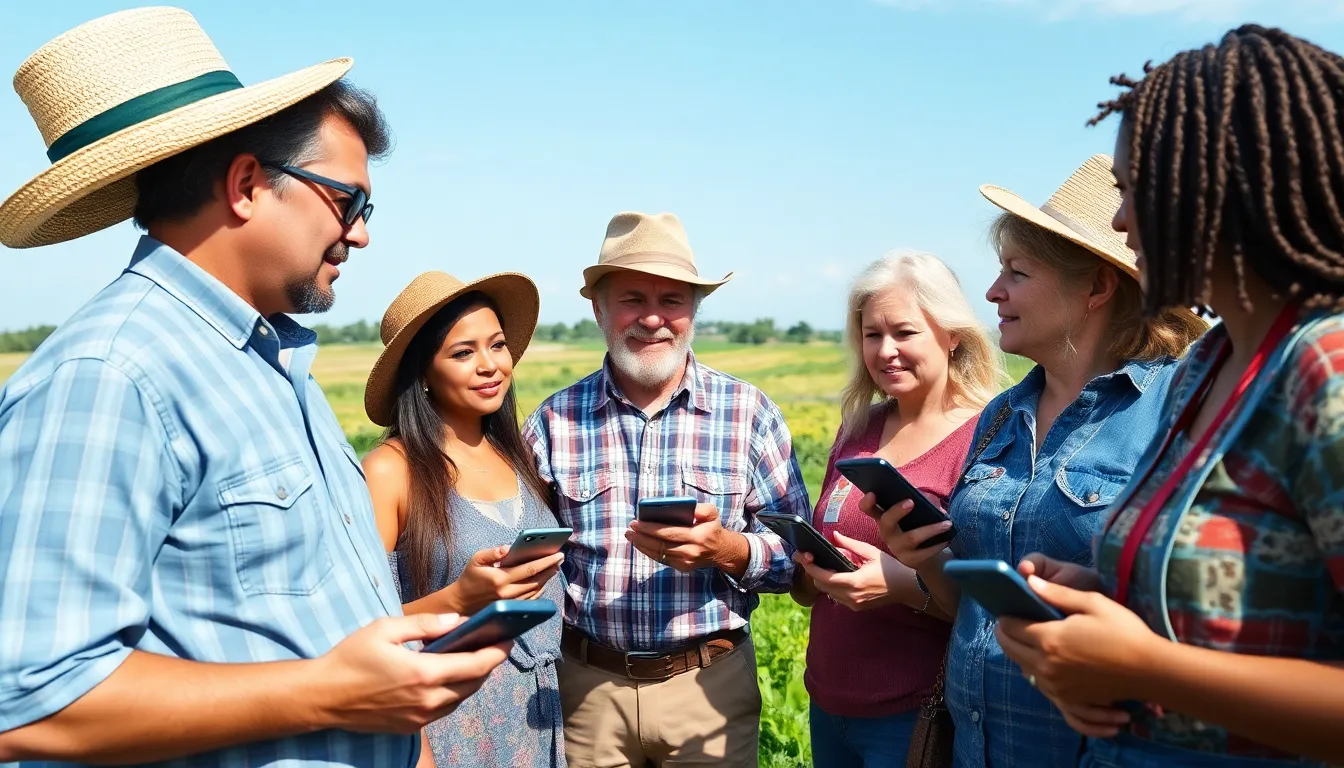In an increasingly digital world, mobile rural connectivity stands as a crucial bridge between urban advancements and rural communities. As technology evolves, the need for reliable mobile networks in remote areas becomes more pressing. Improved connectivity not only enhances communication but also opens doors to education, healthcare, and economic opportunities that were once out of reach.
Despite the challenges posed by geography and infrastructure, innovative solutions are emerging to tackle these issues head-on. By harnessing new technologies and partnerships, rural areas can finally experience the benefits of mobile connectivity. This transformation is vital for empowering individuals and fostering sustainable development in communities that have long been underserved.
Table of Contents
ToggleOverview of Mobile Rural Connectivity
Mobile rural connectivity refers to the development and enhancement of mobile networks in remote areas. Significant barriers exist, including geographical isolation, lack of infrastructure, and high deployment costs. These challenges hinder access to digital services, limiting opportunities for residents.
Mobile connectivity enhances communication, enabling individuals to stay connected with family, friends, and essential services. Access to educational resources improves as online learning platforms become available, offering students in rural communities the ability to engage with educational content directly.
Healthcare services benefit from better connectivity through telemedicine, providing remote consultations and access to medical professionals. This advancement facilitates timely health interventions for individuals in isolated regions.
Economic opportunities increase as mobile connectivity opens new avenues for entrepreneurship. Farmers can access weather forecasts, market prices, and financial services, enhancing productivity and profitability in agricultural sectors.
Innovative solutions include partnerships between government entities, private companies, and non-profit organizations. These collaborations aim to deploy cost-effective technologies like satellite internet and mobile towers, expanding network reach to underserved populations.
Understanding the significance of mobile rural connectivity underscores its role in fostering inclusive growth and sustainable development across various sectors, thereby empowering individuals and communities.
Importance of Mobile Connectivity in Rural Areas

Mobile connectivity plays a crucial role in enhancing the quality of life in rural communities. Reliable mobile networks not only foster communication but also facilitate access to essential services, driving economic growth and social inclusion.
Economic Development
Mobile connectivity stimulates economic development by providing access to critical information and resources. Rural entrepreneurs leverage mobile technology to explore new markets, improve supply chain management, and establish e-commerce platforms. Farmers benefit from real-time data on weather conditions and market prices, enabling informed decision-making. According to a report by the International Telecommunication Union, rural mobile connectivity can increase agricultural productivity by up to 30%. Additionally, businesses gain the ability to reach broader audiences through digital marketing, enhancing their operational efficiency and profitability.
Social Inclusion
Mobile connectivity promotes social inclusion by bridging communication gaps among rural populations. It allows individuals to connect with family and friends, reducing feelings of isolation. Access to mobile networks empowers residents to engage with online educational resources, improving educational outcomes. Furthermore, telemedicine services improve healthcare access, offering remote consultations and timely medical advice. According to a survey by the Pew Research Center, over 70% of rural residents reported relying on mobile devices for healthcare information. Enhanced connectivity ensures marginalized groups participate actively in social, economic, and educational activities, fostering a more inclusive society.
Challenges Facing Mobile Rural Connectivity
Mobile rural connectivity faces several challenges that impede its development and effectiveness. Key obstacles include infrastructure limitations and government policies that do not adequately support rural network expansion.
Infrastructure Limitations
Infrastructure limitations severely impact mobile rural connectivity. Sparse population density leads to lower economic incentives for providers to invest in robust infrastructure. Many remote areas lack the essential physical infrastructure, such as roads and power supply, required for network development. Limited availability of fiber optic cables and cellular towers further exacerbates connectivity issues. According to the Federal Communications Commission, over 14 million people in rural areas remain unserved by mobile broadband services. The geographical isolation of these communities adds complexity to network deployment, resulting in higher costs and longer installation timelines.
Government Policies
Government policies often fail to address the unique challenges of mobile rural connectivity. Insufficient regulatory frameworks can hinder investment by private companies, limiting their ability to operate in rural markets. In many cases, existing subsidies for rural internet services may not reach the areas in dire need, leaving significant gaps in coverage. Additionally, bureaucratic red tape may delay necessary permitting and approvals for infrastructure projects. Collaborative policies that incentivize partnerships between public and private sectors can improve service availability, but these strategies remain underdeveloped. Data from the U.S. Department of Agriculture indicates that targeted investments could significantly enhance mobile connectivity in underserved regions.
Solutions for Enhancing Mobile Connectivity
Enhanced mobile connectivity in rural areas requires innovative technologies and active community involvement. These solutions foster inclusivity and accessibility, effectively addressing existing barriers.
Innovative Technologies
Innovative technologies are crucial for enhancing mobile connectivity in rural areas. Emerging solutions include:
- Satellite Internet: Satellite technology extends network coverage to remote regions. Companies like Starlink and OneWeb provide high-speed internet access even in areas with inadequate ground infrastructure.
- Mobile Hotspots: Portable mobile hotspots allow users to access cellular networks anytime, improving connectivity for individuals and small businesses in sparsely populated areas.
- Rural Broadband Initiatives: Projects like the Connect America Fund focus on funding infrastructure in underserved regions, expanding access to high-speed mobile broadband.
- Wireless Mesh Networks: Mesh networking creates a decentralized network of devices that communicate directly with each other, improving connectivity without extensive cabling or infrastructure.
These technologies provide viable options for addressing the challenges of mobile connectivity in rural landscapes.
Community Involvement
Community involvement plays a vital role in enhancing mobile connectivity. Local engagement initiatives include:
- Community Networks: Collective efforts to build and manage community-owned networks can empower residents to establish their own connectivity solutions, often more cost-effective than commercial services.
- Awareness Programs: Educational campaigns raise awareness about the benefits of mobile connectivity, encouraging local populations to advocate for improved services.
- Partnerships with Local Businesses: Collaborations with local enterprises can facilitate the installation of infrastructure, allowing businesses to contribute to the network’s sustainability and performance.
- Feedback Mechanisms: Establishing channels for community feedback helps identify specific connectivity needs and fosters collaboration with service providers.
Active participation from communities ensures that solutions effectively address local requirements and support sustained improvements in mobile connectivity.
Case Studies of Successful Implementations
Example 1: Project Loon in Rural Areas of Kenya
Project Loon, initiated by Alphabet Inc., deployed high-altitude balloons to provide internet access in remote regions of Kenya. This solution addressed geographical challenges and served communities lacking robust terrestrial networks. By offering connectivity, the project facilitated online education and access to telemedicine, significantly improving quality of life for the residents.
Example 2: Community Networks in Mexico
Cooperatives and local entrepreneurs in rural Mexico established community networks to enhance mobile connectivity. These self-sustaining initiatives used low-cost infrastructure to serve underserved populations. As a result, they fostered local economic growth by enabling access to digital markets, educational tools, and public health resources.
Example 3: Rural Broadband Initiatives in the United States
The Federal Communications Commission (FCC) launched the Connect America Fund to expand broadband access in rural U.S. areas. This initiative incentivized telecom providers to build infrastructure, increasing mobile connectivity significantly. In regions receiving support, residents reported improved business operations and greater access to educational resources.
Example 4: Satellite Technology in India
India’s government collaborated with private companies to leverage satellite technology aimed at enhancing rural connectivity. Through low-earth orbit satellites, remote villages achieved reliable mobile services, fostering better access to healthcare and education. This approach effectively reduced the digital divide between urban and rural populations.
Example 5: Telemedicine Projects in Rural Africa
Various NGOs implemented telemedicine programs in rural Africa, relying on mobile connectivity to offer health consultations. These projects utilized mobile devices to connect patients with healthcare professionals, leading to quicker diagnoses and treatments. The successful rollout of such initiatives showcased the importance of mobile networks in delivering essential services to isolated communities.
Each of these case studies demonstrates the impact of innovative solutions in enhancing mobile rural connectivity, proving effective strategies can address existing challenges and improve the lives of rural residents.
Mobile rural connectivity is essential for transforming lives in underserved communities. By bridging the digital divide it empowers individuals and fosters economic growth. Enhanced communication access to education and improved healthcare services create a foundation for sustainable development.
Innovative solutions and community involvement are crucial for overcoming existing barriers. As technology advances and collaborative efforts increase the potential for rural connectivity becomes even more promising.
Investing in mobile networks not only uplifts rural populations but also contributes to a more inclusive society. With the right strategies and support the future of mobile connectivity in rural areas looks bright.






